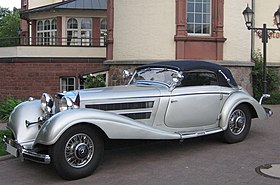TheMercedes-Benz 500K(W29) is agrand touring carbuilt byMercedes-Benzbetween 1934 and 1936. First exhibited at the 1934Berlin Motor Show.[1]It is distinguished from the500 sedanby the "K" forKompressor(German forsupercharger). it succeeded theMercedes-Benz 380introduced the previous year, It offered both a larger, more powerful engine and more opulentcoachworkto meet customers' demands for greater luxury and performance.[2][3]
| Mercedes-Benz 500K | |
|---|---|
 Mercedes-Benz 500K Cabriolet A | |
| Overview | |
| Manufacturer | Mercedes-Benz |
| Production | 1934–1936 |
| Assembly | Sindelfingen,Germany |
| Designer | Friedrich Geiger |
| Body and chassis | |
| Body style | 2-doorconvertible |
| Layout | FR layout |
| Powertrain | |
| Engine | 5,018 cc (5.018 L)I8 |
| Transmission | 4-speed manual optional 5-speedmanual[1] |
| Dimensions | |
| Wheelbase | 2,980 mm (117.3 in) (SWB) 3,290 mm (129.5 in) (LWB) |
| Curb weight | Up to 2,700 kg (6,000 lb) |
| Chronology | |
| Predecessor | Mercedes-Benz 380SSK |
| Successor | Mercedes-Benz 540K |
Specifications
editThe 500K used the sameindependent suspensionas had been introduced on the 380, with adouble wishbonefront axle,double-jointswing axleat the rear, and separate wheel location,coil springsand damping, a world first.[1][2]Consequently, it was a more comfortable and better handling car than Mercedes' previousS/SS/SSKgeneration ofroadstersfrom the 1920s, and offered greater appeal to buyers, particularly the growing number of well-heeled female drivers of the time.[1]
Pressing thethrottlepedal fully engaged theRoots supercharger,[1]inducing the fivelitrestraight-eight engineto produce up to 160horsepower(120 kW) and making the car capable of over 160kilometres per hour(100mph), while consuming fuel at the rate of up to 30 L/100 km (9.4 mpg‑imp;7.8 mpg‑US) as it did so.[1][3]
Three differentchassisand eightbodieswere available for customers;[1][3]the two longer "B" and "C" four-seatcabrioletversions rode on awheelbaseof 3,290 mm (129.5 in), and would later be used on othersedanandtouring carmodels.[1]The short "A" chassis, with a 2,980 mm (117.3 in) wheelbase, underpinned the two-seater models: theMotorway Courier,and the 1936Special Roadsterwhich offered the highest performance.[1][4]All models featured such advanced equipment as safety glass,hydraulic brakes,and a 12-voltelectrical system sufficient to bear the load of the electricwindscreen wipers,door locks,andindicators.[3]
Production figures
editOf the combined production of the 500K (342 cars), including 29 "Special Roadsters" during its two years in production, and the later 540K (419 cars) from Sindelfingen, the deliveries were:[1]
- 70 chassis without body
- 28 open cars (offener Tourenwagen)
- 23 sedans with 4 doors (mainly 500K)
- 29 sedans with 2 doors (mainly 540K)
- 12 Coupés
- 6 Autobahn cruisers (Autobahn-kurier)
- 58 Roadsters
- 116 Cabriolets A
- 296 Cabriolets B
- 122 Cabriolets C
Popular culture
editCruella de Vil,the fictional character inOne Hundred and One Dalmatians,drives a red and black automobile which strongly resembles a Mercedes-Benz 500K Cabriolet, an Alvis Speed 20 and a Bugatti Royale.
Gallery
edit-
1934 Mercedes-Benz 500K, atRétromobile2017
-
Mercedes-Benz 500K from the rear
-
Mercedes-Benz 500K cockpit
-
Mercedes-Benz 500K Autobahn cruiser atNational Car Museum of Iranthat belonged toReza Pahlavi,former Shah of Iran
References
editNotes
edit- ^abcdefghij"1934 - The Mercedes 500K is born".Classicdriver.com. Archived fromthe originalon 2012-02-10.
- ^ab"1935 Mercedes-Benz 500K Special Roadster".Sportscarmarket.com. August 2001. Archived fromthe originalon 2008-10-28.
- ^abcdFrank, Michael (February 5, 2003)."Special K".Forbes.
- ^"The 25 Most Beautiful Cars Ever".Automobile Magazine.
Bibliography
edit- Melin, Jan (1985).Mercedes-Benz: The Supercharged 8-Cylinder Cars of the 1930s.Vol. 1. Gothenburg, Sweden: Nordbok International.ISBN9187036002.
- —————; Hernström, Sven (2003).Mercedes-Benz: The Supercharged 8-Cylinder Cars of the 1930s.Vol. 2. Sparreholm, Sweden: Gamla Bilsalongen.ISBN9163144352.
- Oswald, Werner[in German](2001).Deutsche Autos[German Cars] (in German). Vol. Band [Volume] 2: 1920–1945. Stuttgart: Motorbuch Verlag.ISBN3613021706.
- ——————— (2018).Mercedes-Benz Personenwagen 1886-1986[Mercedes-Benz Passenger Cars 1886-1986] (in German). Stuttgart: Motorbuch Verlag.ISBN9783613041288.
External links
edit- [1]Mercedes-Benz Classic Center USApresents the 500K Cabriolet atAmelia Island Concours d'Elegance
- [2]Klassik-Oldtimer-Klatt presents the 500K Cabriolet